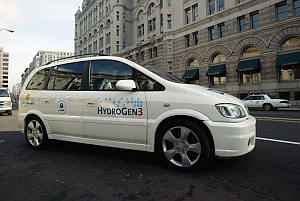Fleet Management at EPA
 EPA had a demonstration project to test a hydrogen vehicle in its Washington, DC, Headquarters fleet.
EPA had a demonstration project to test a hydrogen vehicle in its Washington, DC, Headquarters fleet.EPA is protecting human health and the environment while also meeting federal fleet requirements by utilizing alternative fuel vehicles (AFVs). AFVs can reduce greenhouse gas (GHG) emissions and other air pollutants and increase fuel efficiency. Some examples of AFVs include:
- Zero-emission vehicles (ZEVs)
- Plug-in hybrid electric vehicles (PHEVs)
- Ethanol-fueled vehicles
- Low greenhouse gas-emitting vehicles (LGVs)
EPA is committed to acquiring AFVs and other advanced technology vehicles, while leading other federal agencies by example. EPA has exceeded federal AFV acquisition requirements every year since 1999. EPA will continue to acquire PHEVs, ZEVs and LGVs in order to reduce per-mile GHG emissions.
The Agency has also met federal requirements to fully integrate fleet data into an Agency fleet management information system (FMIS), the Federal Automotive Statistical Tool (FAST), FleetDASH and the Federal Motor Vehicle Registration System (FMVRS). EPA will continue to develop strategies to meet and exceed the fleet goals of Executive Order 13693.
- Read EPA’s annual AFV reports.
This report provides information on how EPA is greening its fleet with AFV acquisitions.
Vehicle Acquisition Methodology
EPA’s vehicle allocation methodology (VAM) helps fleet managers determine the optimal fleet inventory needed to meet mission requirements. The goal of the VAM is to eliminate unnecessary or non-essential vehicles from the Agency's fleet. EPA reviews its VAM annually to identify where additional reductions can be made.
